Belgium's beloved rat catcher, the Brussels Griffon, is a breed of small dogs that has gained worldwide admiration. With their distinct appearance, endearing human-like faces, and playful nature, these delightful companions have captured the hearts of dog lovers everywhere.
Originally bred for rat hunting, the Brussels Griffon has adapted well to apartment living, making them a popular choice for urban dwellers. But there is much more to discover about this captivating breed, from their feline tendencies to their famous pet parents.
So, what makes the Brussels Griffon so charming and unique? Stay tuned to find out more about their origins, characteristics, and the care they require.
Key Takeaways
- The Brussels Griffon is a small companion dog breed that originated in Belgium.
- They have a friendly, affectionate, and intelligent temperament.
- Brussels Griffons have a short, wiry coat and may exhibit feline tendencies such as climbing and vocalizing.
- When choosing a dog for an apartment, factors to consider include size, energy levels, quietness, good manners, and the comfort of neighbors.
Origin and History
The Brussels Griffon, a small breed of dog known for its distinctive appearance and friendly demeanor, originated in Belgium and has a fascinating history.
This breed was developed in the city of Brussels during the 19th century, where they were primarily used to hunt rats and mice in stables. The Brussels Griffon is believed to be a result of crossbreeding between the Affenpinscher, the Pug, and the Ruby Spaniel.
Over time, these dogs gained popularity among the upper class as companion animals. They were often seen accompanying their owners to parties and social events. The breed faced a decline during World War I but was revived in the 1940s.
Today, the Brussels Griffon is known for its loving nature and makes an excellent family pet.
Size and Appearance

With their distinctive appearance and almost human-like faces, Brussels Griffons are known for their unique size and appearance. These small dogs stand at around 10-12 inches tall at the shoulder and weigh between 7-12 pounds. Their compact size makes them perfect for apartment living. Brussels Griffons come in two types in the United States: the rough-coated and the smooth-coated. The rough-coated variety has a wiry coat, while the smooth-coated variety has a short coat. Both types have a charming and expressive face that captures the attention of anyone who sees them. Their heavy and athletic build allows them to excel in agility and obedience. Despite their small size, Brussels Griffons possess a confident and lively personality that matches their one-of-a-kind appearance.
| Size | Height | Weight |
|---|---|---|
| Small | 10-12 inches | 7-12 pounds |
Temperament and Personality

Brussels Griffons are known for their friendly, playful, and affectionate temperament. These charming dogs form strong bonds with their owners and are especially good for novice owners. They've a low sensitivity level and can tolerate being alone for periods of time.
Brussels Griffons are also adaptable to different weather conditions, including both cold and hot weather. With their all-around friendliness, they make great companions for families.
However, it's important to note that aggression in dogs can sometimes stem from fear and anxiety, so it's essential to provide a loving and supportive environment for these dogs.
Additionally, while Brussels Griffons are generally not prone to excessive barking or howling, each individual dog may vary in vocalization.
Exercise and Training Needs
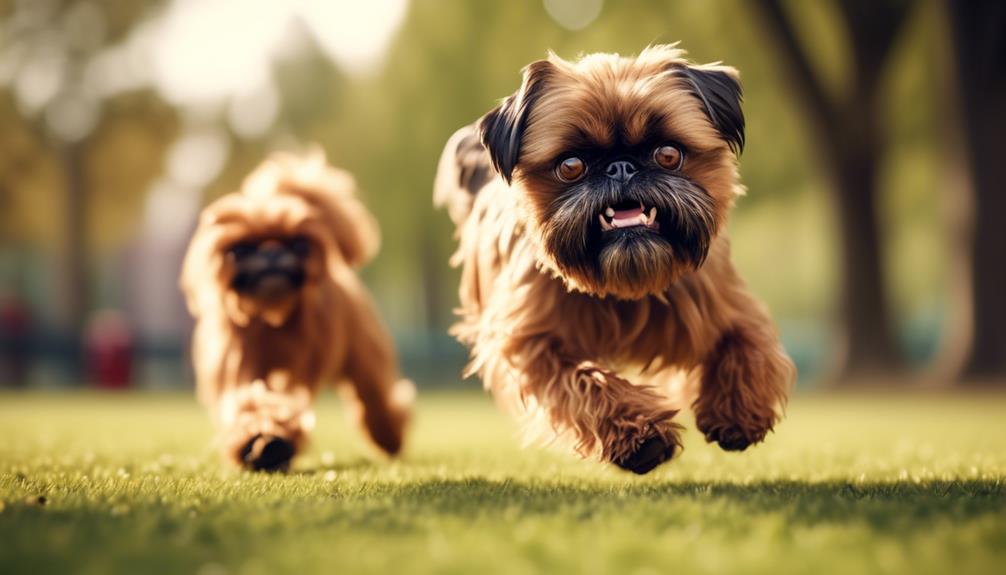
Known for their friendly and affectionate temperament, Brussels Griffons also have specific exercise and training needs to keep them happy and healthy.
Here are three important aspects to consider when it comes to their exercise and training:
- Mental Stimulation: Brussels Griffons are intelligent dogs that thrive on mental stimulation. They enjoy puzzle toys, interactive games, and obedience training sessions to keep their minds sharp and engaged.
- Regular Exercise: While Brussels Griffons have low exercise needs compared to some other breeds, they still require daily exercise to maintain their overall health. A short walk or play session in the backyard is usually sufficient to meet their exercise requirements.
- Positive Reinforcement Training: Brussels Griffons are easy to train and respond well to positive reinforcement techniques. Using rewards such as treats, praise, and playtime, along with consistency and patience, will help them learn quickly and reinforce good behavior.
Health Concerns and Care
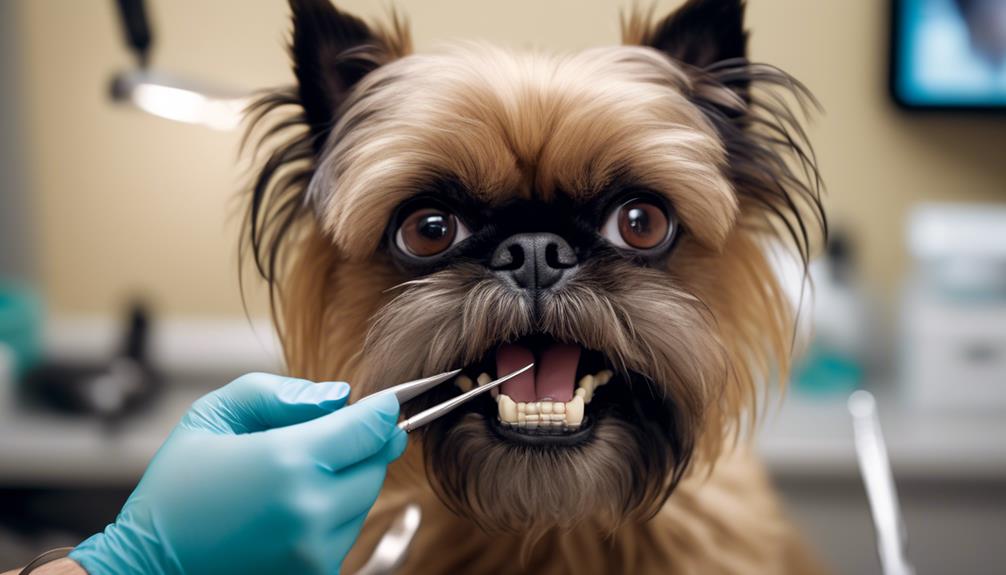
Taking proper care of a Brussels Griffon involves being aware of their specific health concerns. While generally healthy, this breed is prone to certain conditions such as hip dysplasia, patellar luxation, eye problems, and skin allergies.
Regular exercise is essential for these indoor dogs, regardless of the size of their living space. Feeding them high-quality food is also important to maintain their overall health.
The Brussels Griffon comes in two varieties – rough-coated and smooth-coated – each with different grooming needs.
When it comes to children and other pets, they may not tolerate certain behaviors, so proper introduction and supervision are crucial.
It's also advisable to seek out reputable breeders or rescue groups for adoption to ensure the health and well-being of these charming rat catchers.
Adaptability to Apartment Living

To ensure the well-being of these charming rat catchers, it's important to consider their adaptability to apartment living. Brussels Griffons are known to adapt well to apartment living, making them suitable for urban environments. However, there are a few factors to keep in mind when considering their adaptability:
- Size isn't the only factor: While Brussels Griffons are small in size, it isn't the sole factor to consider when choosing a dog for an apartment. Other qualities such as being quiet, low-energy, and displaying good manners towards neighbors should also be prioritized.
- Energy levels: Small dogs with high energy levels may not be suitable for apartment living. It's important to match their energy levels with the available space and exercise opportunities.
- Consider neighbors' comfort: When selecting a dog for an apartment, it's crucial to consider the comfort of other residents. Dogs that are quiet and well-behaved are more likely to be welcomed in shared living spaces.
Choosing the Right Dog for an Apartment
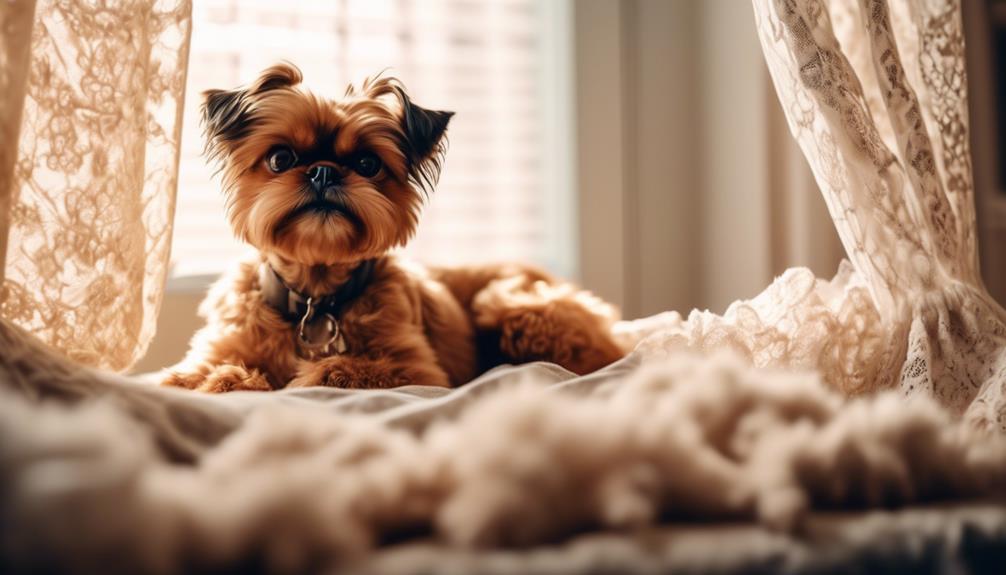
When selecting a dog for an apartment, it's important to consider various factors such as size, energy levels, and good manners towards neighbors. Size isn't the only factor to consider; qualities such as being quiet and low-energy are also important. Small dogs with high energy levels may not be suitable for apartment living.
It's crucial to prioritize the comfort of other residents when choosing a dog for an apartment. Dogs that are quiet, well-behaved, and display good manners towards neighbors will help create a harmonious living environment.
Additionally, it's essential to consider the exercise needs of the dog and ensure that they can be adequately met within the confines of an apartment.
All-Around Friendliness and Compatibility
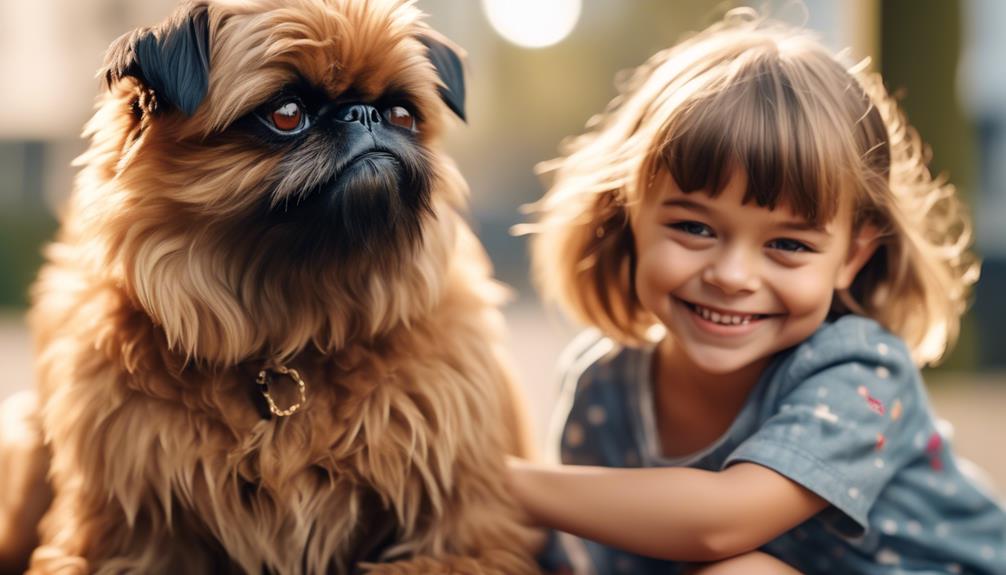
After considering the factors for choosing the right dog for an apartment, it's important to assess the all-around friendliness and compatibility of the potential canine companion. When it comes to the Brussels Griffon, here are three key aspects to consider:
- Affectionate with family: The Brussels Griffon forms strong bonds with their owners and is known for being affectionate towards their family members. They thrive on human companionship and enjoy being a part of the family unit.
- Good for novice owners: This breed is generally easy to train and is suitable for novice owners who may not have much experience in dog ownership. They're intelligent and eager to please, making training sessions enjoyable and effective.
- Tolerates being alone: While the Brussels Griffon enjoys being with their family, they can also tolerate being alone for short periods of time. This makes them a suitable choice for individuals who work outside the home or have other commitments.
These characteristics of the Brussels Griffon contribute to their all-around friendliness and compatibility as a potential apartment dog.
Understanding Aggression in Dogs

Aggression in dogs can arise from fear and anxiety, often leading to potentially dangerous situations. Understanding the causes of aggression can help dog owners and handlers manage and prevent aggressive behavior. Here is a table that summarizes some common triggers of aggression in dogs:
| Trigger | Description | Examples |
|---|---|---|
| Fear | Feeling threatened or scared | Loud noises, unfamiliar people or animals |
| Resource Guarding | Protecting valuable items like food or toys | Growling or snapping when approached |
| Territorialism | Defending their territory or personal space | Barking or lunging at perceived intruders |
Addressing aggression in dogs requires a tailored approach that may include training, behavior modification, and addressing the underlying causes. Seeking guidance from a professional dog trainer or behaviorist is recommended to ensure the safety of both the dog and those around them.
Dealing With Barking and Howling

To address excessive barking and howling in dogs, owners can implement effective training techniques and provide appropriate mental and physical stimulation. Here are three strategies to help manage and reduce barking and howling:
- Consistent training: Teaching a dog the 'quiet' command and rewarding them for being calm can help them understand when it's appropriate to bark and when it's not.
- Mental and physical stimulation: Providing dogs with plenty of exercise and mental stimulation through activities like puzzle toys, interactive games, and obedience training can help reduce boredom and excessive vocalization.
- Identifying triggers: Understanding what triggers a dog's barking or howling can help owners address the root cause. It might be separation anxiety, fear, or attention-seeking behavior. Identifying and addressing the trigger can help reduce the unwanted vocalization.
Managing Wanderlust Potential
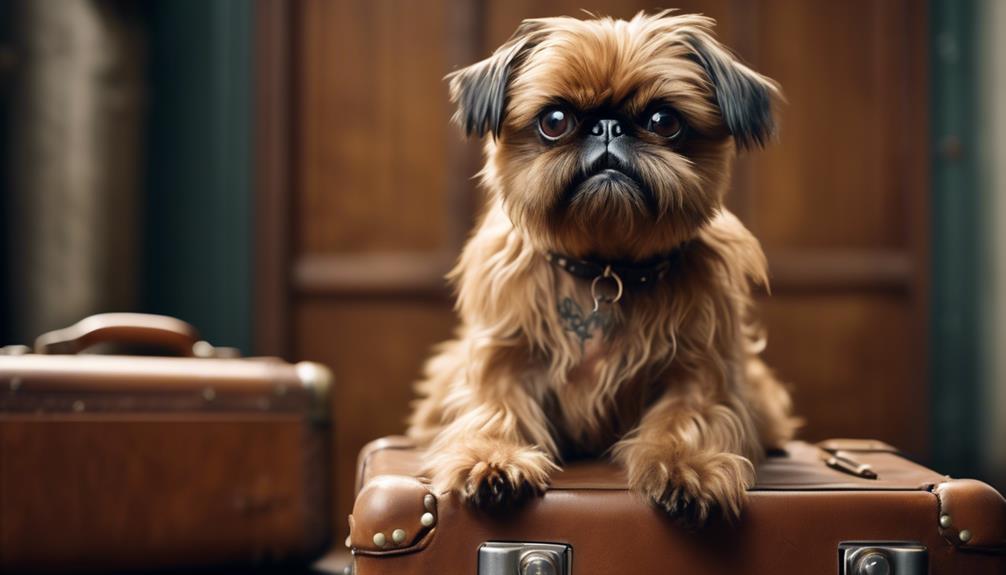
One effective way to manage a dog's wanderlust potential is by providing them with regular exercise and mental stimulation. By engaging in activities that challenge their mind and tire them out physically, dogs are less likely to feel the urge to wander. Additionally, it is important to establish strong boundaries and reinforce obedience training to ensure that the dog understands their limits and stays within the designated area. Incorporating interactive toys, puzzle games, and training sessions into their daily routine can help keep their minds stimulated and prevent boredom, which is often a trigger for wanderlust. Furthermore, providing a safe and secure outdoor space for the dog to explore and play can also help satisfy their natural curiosity without the risk of them running off.
| Exercise and Mental Stimulation | Boundary and Obedience Training | Interactive Toys and Games |
|---|---|---|
| Regular exercise sessions such as walks, runs, or playtime in the backyard can help tire the dog out and reduce their desire to wander. | Establishing clear boundaries and reinforcing obedience training can teach the dog to stay within the designated area and not stray too far. | Interactive toys and games, such as puzzle toys or treat-dispensing toys, can keep the dog mentally stimulated and prevent boredom, which may lead to wanderlust. |
| Engaging in mentally stimulating activities like training sessions or learning new tricks can keep the dog's mind occupied and reduce their urge to explore. | Using positive reinforcement techniques during obedience training and rewarding the dog for staying within the boundaries can reinforce good behavior and discourage wandering. | Incorporating interactive games that require the dog to problem-solve or search for treats can provide mental stimulation and prevent boredom-induced wanderlust. |
| Providing opportunities for the dog to engage in activities that cater to their natural instincts, such as scent work or agility training, can help satisfy their need for mental and physical stimulation. | Consistency in enforcing boundaries and obedience commands can help establish a sense of security and reduce the dog's desire to wander off. | Rotating different types of interactive toys and games can keep the dog engaged and prevent them from seeking excitement elsewhere. |
| Varying the types of exercise and mental stimulation provided can keep the dog interested and prevent them from becoming bored, which may lead to wandering behavior. | Using visual markers or physical barriers to define the boundaries can help the dog understand their limits and stay within the designated area. | Incorporating interactive games that require problem-solving or offer rewards can keep the dog mentally engaged and discourage them from seeking stimulation outside the home. |
| Engaging in activities that require the dog to use their senses, such as scent games or tracking exercises, can provide mental stimulation and prevent restlessness. | Regularly reinforcing obedience training and practicing recall exercises can help ensure that the dog responds reliably to commands and stays close to their owner. | Providing a variety of interactive toys and games can cater to the dog's individual preferences and keep them engaged for longer periods. |
Matching Exercise Needs
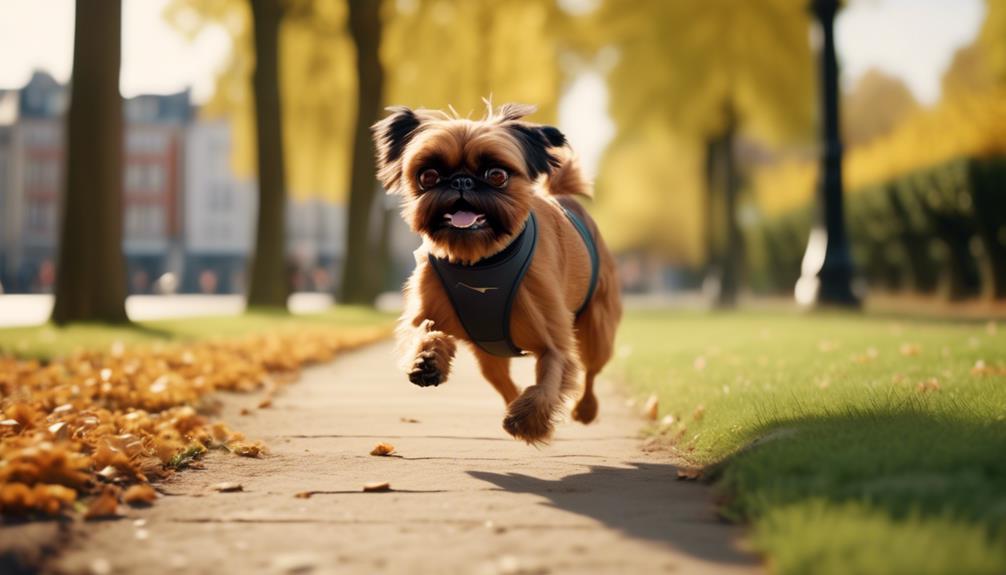
By ensuring that a dog's exercise needs are properly matched, owners can promote their overall well-being and prevent behavioral issues. When it comes to the Brussels Griffon, it's important to take into account their low exercise needs. Here are three things to consider when matching their exercise needs:
- Low energy levels: Brussels Griffons don't require intense physical activity. They're content with short walks and play sessions.
- Mental stimulation: Although they may not need a lot of physical exercise, Brussels Griffons benefit from mental stimulation. Engaging them in puzzle toys or training sessions can help keep their minds sharp.
- Bonding time: Spending quality time with your Brussels Griffon through activities such as gentle play or snuggling can meet their exercise needs while also strengthening the bond between you and your furry companion.
Considering the Intensity of Dogs

Considering the intensity of dogs is crucial when selecting the right breed for your lifestyle and home environment. Some dogs have a higher intensity level, which may not be suitable for certain households. Intense dogs require a lot of mental and physical stimulation to stay happy and healthy. They tend to have high energy levels and may display behaviors such as excessive barking, destructive chewing, and hyperactivity. It's important to provide them with plenty of exercise and mental stimulation to prevent boredom and frustration. If you're not able to meet the intensity needs of a dog, it may lead to behavioral issues and a less than ideal living situation for both you and the dog.
| Intensity Level | Characteristics | Suitable Home Environment |
|---|---|---|
| Low | Calm, laid-back | Apartments, small homes |
| Medium | Moderate energy | Homes with a yard |
| High | High energy | Active individuals, large homes with space to run |
Understanding the intensity of dogs can help you make an informed decision and find a breed that aligns with your lifestyle and home environment.
Frequently Asked Questions
Are Brussels Griffons Hypoallergenic?
Yes, Brussels Griffons are hypoallergenic. Their wiry coat sheds minimally and produces less dander, making them a good choice for those with allergies. However, individual reactions may still vary.
How Much Do Brussels Griffons Shed?
Brussels Griffons shed minimally due to their short, wiry coat. Regular brushing can help manage any loose hairs. However, shedding patterns may vary among individual dogs, so it is best to consult with a breeder or veterinarian for specific information.
Are Brussels Griffons Good With Children?
Brussels Griffons can be good with children, but they may not tolerate certain behaviors. It is important to introduce them properly and supervise interactions. Rescue groups and breed organizations can provide resources for adoption and finding reputable breeders.
Can Brussels Griffons Be Left Alone for Long Periods of Time?
Yes, Brussels Griffons can be left alone for long periods of time. However, they are social dogs and may experience separation anxiety. It is recommended to gradually increase the time they are left alone and provide them with toys and mental stimulation.
Do Brussels Griffons Have a Strong Prey Drive?
Yes, Brussels Griffons have a strong prey drive. Like their rat-catching ancestors, they are instinctively driven to chase small animals. It's important to provide them with proper training and supervision to manage this behavior.
Are Boston Boxers also effective at catching rats like the Brussels Griffon?
Yes, Boston Boxers are also effective at catching rats like the Brussels Griffon. Despite their charming personality, Boston Boxers have the tenacity and hunting instincts to chase and catch rodents. Their agility and alert nature make them great at hunting down and catching rats in a similar manner as the Brussels Griffon.
Conclusion
In conclusion, the Brussels Griffon is a captivating and charming breed that has won the hearts of dog lovers around the world.
With their distinctive appearance, playful personalities, and adaptability to apartment living, they make the perfect companions for urban dwellers.
From their feline tendencies to their versatility in agility and obedience, these little rat catchers have it all.
So if you're looking for a delightful and intelligent canine companion, look no further than the endearing Brussels Griffon.




